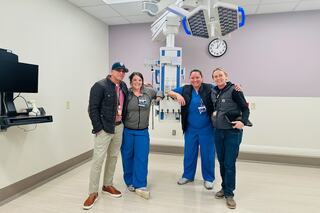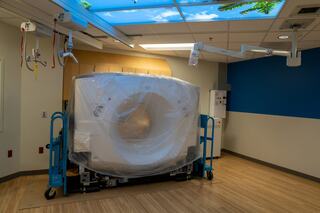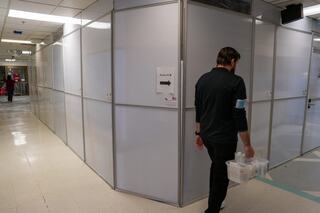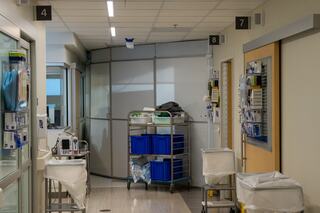Building While Caring: Minimizing Construction Impacts in an Active ED

Lewis is midway through a 57,000-square-foot emergency department (ED) renovation project at Providence St. Vincent Medical Center (PSV) in Portland, Oregon.
The project involves expanding the patient room count from 52 beds to 72. It also includes a new and improved imaging department, universal exam rooms, the relocation of the behavioral health unit and the installation of a new air handler unit. Together, these ED renovations will allow the hospital to greatly reduce the triage time it takes for patients to receive vital medical care and increase the ED’s general capacity, limiting the possibility of patients being sent to other hospitals.
Work is taking place while the ED is actively providing care for the community.
A variety of equipment and procedures have helped reduce the impacts of construction. For example, the Lewis team has deployed a system of modular walls that closes construction off from the hospital, ensuring the highest levels of infection control and dust containment and that all active construction is taking place in negative air. Maintaining lower air pressure in the construction zone helps reduce the risk of cross-contamination to the surrounding spaces.
We also restrict our loudest work to occur between 6 a.m. and 10 a.m. when patient counts are the lowest.
Lewis is midway through a 57,000-square-foot emergency department (ED) renovation project at Providence St. Vincent Medical Center (PSV) in Portland, Oregon.
The project involves expanding the patient room count from 52 beds to 72. It also includes a new and improved imaging department, universal exam rooms, the relocation of the behavioral health unit and the installation of a new air handler unit. Together, these ED renovations will allow the hospital to greatly reduce the triage time it takes for patients to receive vital medical care and increase the ED’s general capacity, limiting the possibility of patients being sent to other hospitals.
Work is taking place while the ED is actively providing care for the community.
A variety of equipment and procedures have helped reduce the impacts of construction. For example, the Lewis team has deployed a system of modular walls that closes construction off from the hospital, ensuring the highest levels of infection control and dust containment and that all active construction is taking place in negative air. Maintaining lower air pressure in the construction zone helps reduce the risk of cross-contamination to the surrounding spaces.
We also restrict our loudest work to occur between 6 a.m. and 10 a.m. when patient counts are the lowest.

A new imaging department is coming to Providence St. Vincent Medical Center.
Yet many impacts cannot be avoided, including noise and vibrations. Mitigating these at an extremely sensitive jobsite requires the highest level of coordination and collaboration between Lewis and the user group.
Lewis has engaged the hospital’s ED nurse manager Alexia Afzali and her team since project design first began. Her input has subsequently informed the project team’s comprehensive six-phased schedule and logistics plan.
“Through this whole process, good communication has been instrumental,” Alexia says of the current ED reconfiguration project. “It’s essential to have open lines and a dedicated point of contact that remains from start to finish.”
As a nurse who has spent the past nine years at PSV, Alexia has daily meetings with Lewis general foreman Cindy Benton and PSV project manager Amy Brooks to align hospital administration, care teams, and the Lewis field team.
Ensuring that Alexia and her colleagues have a voice in the project allows Lewis to anticipate potential disruptions or impacts to both patients and care providers resulting from power shutdowns, schedule changes or unanticipated noise. Anticipating these impacts allows Lewis to take steps to minimize them.

Modular walls separate construction from hospital operations and mitigate cross-contamination, noise and distracting visuals.
These conversations also fortify and expand our relationship with healthcare providers, providing a vital opportunity to build a deeper connection to the hospital’s role in the community—and the role that enhanced facilities can play.
“Working this close to patients is hard for all parties involved,” said Lewis’ Cindy Benton. “It helps to consider that the patient next door could be your daughter or your mother. This mindset helps with the added challenges of working in an occupied space.”
Once a phase is complete, conversations and feedback from user groups play a significant role in our ability to reflect and improve during subsequent ones.
With the PSV project now advancing to its second phase, Alexia has shared some lessons learned, suggesting the project team breaks construction zones into smaller sections to create multiple targeted and precise construction areas within a zone, allowing hospital staff to plan for and predict construction impact on their workspace more accurately.
Alexia has also expressed an interest in having more caregivers involved at the front end of capital projects. “Having nurses walk the space and thinking through all the changes could further reduce oversights and optimize space utilization,” she said.
For David Torres, Lewis’ superintendent on the ED project, Lewis’ approach is to try to see things from the perspective of a caregiver first and a builder second.
“Our message to user groups is that Lewis leads with empathy, consideration and close collaboration first and foremost,” he said. “I believe this is evident in the trust and partnerships we build on these healthcare campuses.

Construction is taking place behind modular walls next to patient rooms.